

Compact Muon Solenoid
LHC, CERN
| CMS-SUS-17-010 ; CERN-EP-2018-186 | ||
| Searches for pair production of charginos and top squarks in final states with two oppositely charged leptons in proton-proton collisions at $\sqrt{s} = $ 13 TeV | ||
| CMS Collaboration | ||
| 20 July 2018 | ||
| JHEP 11 (2018) 079 | ||
| Abstract: A search for pair production of supersymmetric particles in events with two oppositely charged leptons (electrons or muons) and missing transverse momentum is reported. The data sample corresponds to an integrated luminosity of 35.9 fb$^{-1}$ of proton-proton collisions at $\sqrt{s} = $ 13 TeV collected with the CMS detector during the 2016 data taking period at the LHC. No significant deviation is observed from the predicted standard model background. The results are interpreted in terms of several simplified models for chargino and top squark pair production, assuming $R$-parity conservation and with the neutralino as the lightest supersymmetric particle. When the chargino is assumed to undergo a cascade decay through sleptons, with a slepton mass equal to the average of the chargino and neutralino masses, exclusion limits at 95% confidence level are set on the masses of the chargino and neutralino up to 800 and 320 GeV, respectively. For the top squark pair production, the search focuses on models with a small mass difference between the top squark and the lightest neutralino. When the top squark decays into an off-shell top quark and a neutralino, the limits extend up to 420 and 360 GeV for the top squark and neutralino masses, respectively. | ||
| Links: e-print arXiv:1807.07799 [hep-ex] (PDF) ; CDS record ; inSPIRE record ; CADI line (restricted) ; | ||
| Figures & Tables | Summary | Additional Figures & Tables | References | CMS Publications |
|---|
| Additional information on efficiencies needed for reinterpretation of these results are available here. Additional technical material for CMS speakers can be found here. |
| Figures | |

png pdf |
Figure 1:
Simplified-models diagrams of the chargino pair production with two benchmark decay modes: the left plot shows decays through intermediate sleptons or sneutrinos, while the right one displays prompt decays into a W boson and the lightest neutralino. |
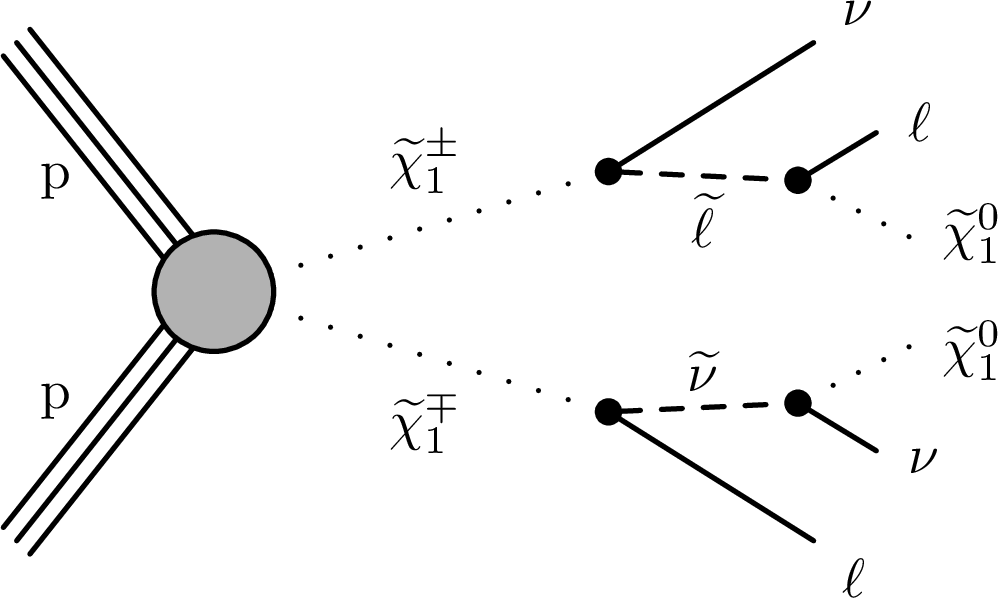
png pdf |
Figure 1-a:
Simplified-model diagram of the chargino pair production with decays through intermediate sleptons or sneutrinos. |

png pdf |
Figure 1-b:
Simplified-model diagram of the chargino pair production with prompt decays into a W boson and the lightest neutralino. |

png pdf |
Figure 2:
Simplified-models diagrams of the top squark pair production with two benchmark decay modes of the top squark: the left plot shows decays into a top quark and the lightest neutralino, while the right one displays prompt decays into a bottom quark and a chargino, further decaying into a neutralino and a W boson. |
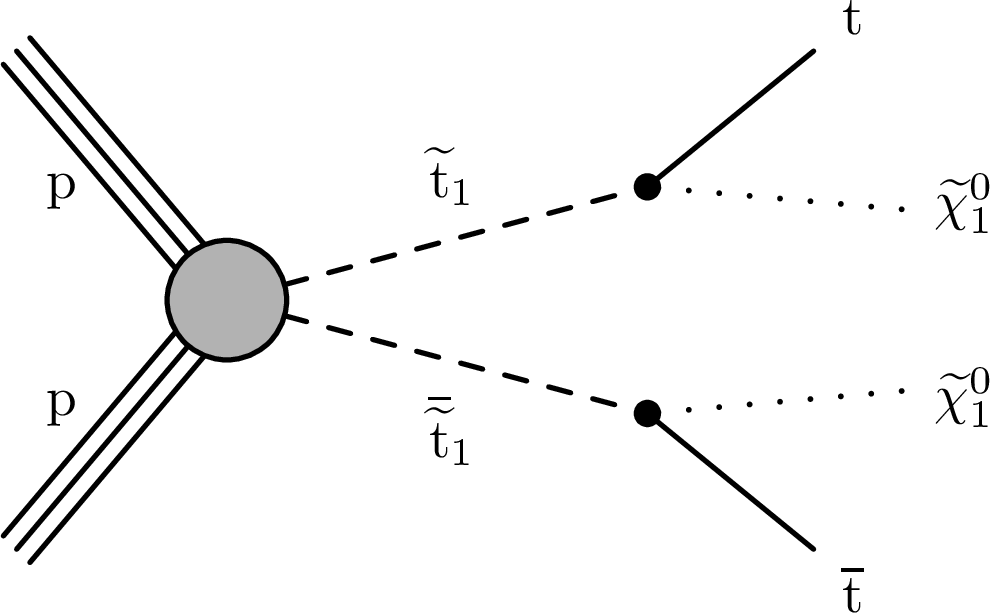
png pdf |
Figure 2-a:
Simplified-model diagram of the top squark pair production with top squark decays into a top quark and the lightest neutralino. |
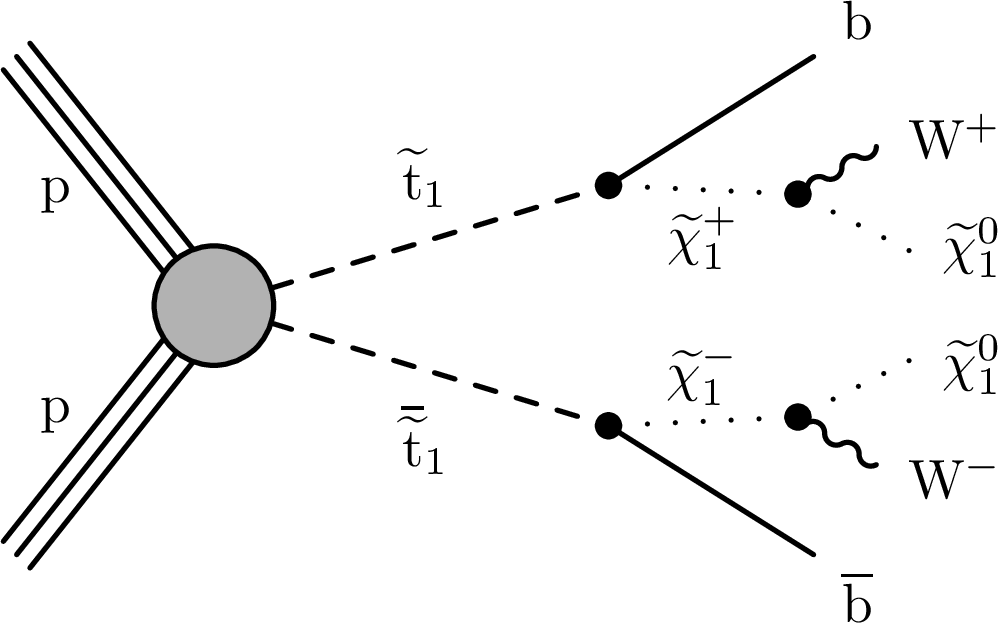
png pdf |
Figure 2-b:
Simplified-model diagram of the top squark pair production with top squark prompt decays into a bottom quark and a chargino, further decaying into a neutralino and a W boson. |

png pdf |
Figure 3:
Observed and SM expected distributions of some observables used to define the SRs for events with two OC isolated leptons and $ {{p_{\mathrm {T}}} ^\text {miss}} \geq $ 140 GeV. Clockwise from top left: ${{p_{\mathrm {T}}} ^\text {miss}}$, ${{m_\mathrm {T2}} (\ell \ell)}$, ${\Delta \phi}$ between the ${\vec{p}}_{\mathrm {T}}^{\,\text {miss}} $ and the leading jet (required not to be b-tagged and with $ {p_{\mathrm {T}}} > $ 150 GeV, events missing this requirements are shown in the first bin), and multiplicity of b-tagged jets in the event. The last bin includes the overflow entries. In the bottom panel, the ratio of observed and expected yields is shown. The hatched band represents the total uncertainty in the background expectation, as described in Section 7. |

png pdf |
Figure 3-a:
Observed and SM expected distributions of ${{p_{\mathrm {T}}} ^\text {miss}}$, one of the observables used to define the SRs for events with two OC isolated leptons and $ {{p_{\mathrm {T}}} ^\text {miss}} \geq $ 140 GeV. The last bin includes the overflow entries. In the bottom panel, the ratio of observed and expected yields is shown. The hatched band represents the total uncertainty in the background expectation, as described in Section 7. |

png pdf |
Figure 3-b:
Observed and SM expected distributions of ${{m_\mathrm {T2}} (\ell \ell)}$, one of the observables used to define the SRs for events with two OC isolated leptons and $ {{p_{\mathrm {T}}} ^\text {miss}} \geq $ 140 GeV. The last bin includes the overflow entries. In the bottom panel, the ratio of observed and expected yields is shown. The hatched band represents the total uncertainty in the background expectation, as described in Section 7. |
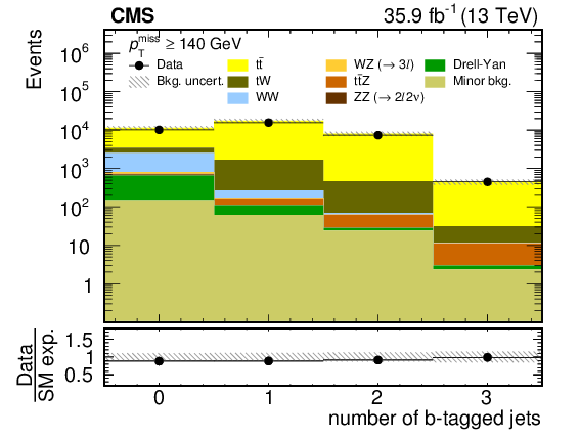
png pdf |
Figure 3-c:
Observed and SM expected distributions of the multiplicity of b-tagged jets in the event, one of the observables used to define the SRs for events with two OC isolated leptons and $ {{p_{\mathrm {T}}} ^\text {miss}} \geq $ 140 GeV. The last bin includes the overflow entries. In the bottom panel, the ratio of observed and expected yields is shown. The hatched band represents the total uncertainty in the background expectation, as described in Section 7. |

png pdf |
Figure 3-d:
Observed and SM expected distributions of ${\Delta \phi}$ between the ${\vec{p}}_{\mathrm {T}}^{\,\text {miss}} $ and the leading jet (required not to be b-tagged and with $ {p_{\mathrm {T}}} > $ 150 GeV, events missing this requirements are shown in the first bin), one of the observables used to define the SRs for events with two OC isolated leptons and $ {{p_{\mathrm {T}}} ^\text {miss}} \geq $ 140 GeV. The last bin includes the overflow entries. In the bottom panel, the ratio of observed and expected yields is shown. The hatched band represents the total uncertainty in the background expectation, as described in Section 7. |

png pdf |
Figure 4:
Distributions of ${{m_\mathrm {T2}} (\ell \ell)}$ after the fit to data in the chargino SRs with 140 $ < {{p_{\mathrm {T}}} ^\text {miss}} < $ 200 GeV (upper plots), 200 $ < {{p_{\mathrm {T}}} ^\text {miss}} < $ 300 GeV (middle), and $ {{p_{\mathrm {T}}} ^\text {miss}} > $ 300 GeV (lower), for DF events without b-tagged jets and at least one jet (left plots) and no jets (right plots). The lower plot for the SR with $ {{p_{\mathrm {T}}} ^\text {miss}} > $ 300 GeV shows all the events without b-tagged jets regardless of their jet multiplicity. The solid magenta histogram shows the expected ${{m_\mathrm {T2}} (\ell \ell)}$ distribution for chargino pair production with $ {m_{\tilde{\chi}^\pm _{1}}} = $ 500 GeV and $ {m_{\tilde{\chi}^{0}_{1}}} = $ 200 GeV. Expected total SM contributions before the fit (dark blue dashed line) and after a background+signal fit (dark red dotted line) are also shown. The last bin includes the overflow entries. In the bottom panel, the ratio of data and SM expectations is shown for the expected total SM contribution after the fit using the background-only hypothesis (black dots) and before any fit (dark blue dashed line). The hatched band represents the total uncertainty after the fit. |
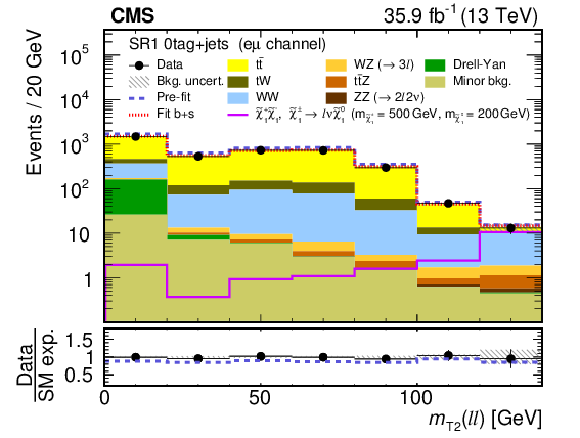
png pdf |
Figure 4-a:
Distribution of ${{m_\mathrm {T2}} (\ell \ell)}$ after the fit to data in the chargino SR with 140 $ < {{p_{\mathrm {T}}} ^\text {miss}} < $ 200 GeV for DF events without b-tagged jets and at least one jet. The solid magenta histogram shows the expected ${{m_\mathrm {T2}} (\ell \ell)}$ distribution for chargino pair production with $ {m_{\tilde{\chi}^\pm _{1}}} = $ 500 GeV and $ {m_{\tilde{\chi}^{0}_{1}}} = $ 200 GeV. Expected total SM contributions before the fit (dark blue dashed line) and after a background+signal fit (dark red dotted line) are also shown. The last bin includes the overflow entries. In the bottom panel, the ratio of data and SM expectations is shown for the expected total SM contribution after the fit using the background-only hypothesis (black dots) and before any fit (dark blue dashed line). The hatched band represents the total uncertainty after the fit. |

png pdf |
Figure 4-b:
Distribution of ${{m_\mathrm {T2}} (\ell \ell)}$ after the fit to data in the chargino SR with 140 $ < {{p_{\mathrm {T}}} ^\text {miss}} < $ 200 GeV for DF events with no jet. The solid magenta histogram shows the expected ${{m_\mathrm {T2}} (\ell \ell)}$ distribution for chargino pair production with $ {m_{\tilde{\chi}^\pm _{1}}} = $ 500 GeV and $ {m_{\tilde{\chi}^{0}_{1}}} = $ 200 GeV. Expected total SM contributions before the fit (dark blue dashed line) and after a background+signal fit (dark red dotted line) are also shown. The last bin includes the overflow entries. In the bottom panel, the ratio of data and SM expectations is shown for the expected total SM contribution after the fit using the background-only hypothesis (black dots) and before any fit (dark blue dashed line). The hatched band represents the total uncertainty after the fit. |
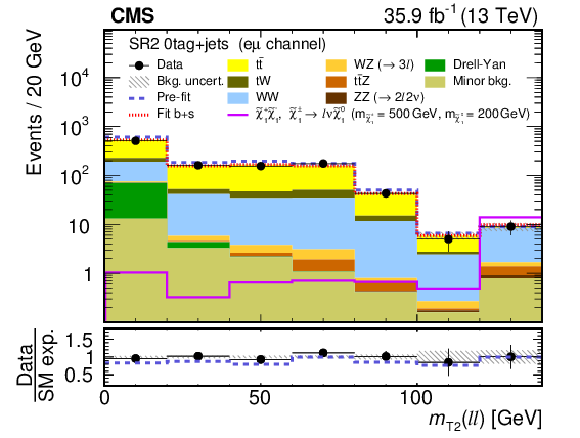
png pdf |
Figure 4-c:
Distribution of ${{m_\mathrm {T2}} (\ell \ell)}$ after the fit to data in the chargino SR with 200 $ < {{p_{\mathrm {T}}} ^\text {miss}} < $ 300 GeV for DF events without b-tagged jets and at least one jet. The solid magenta histogram shows the expected ${{m_\mathrm {T2}} (\ell \ell)}$ distribution for chargino pair production with $ {m_{\tilde{\chi}^\pm _{1}}} = $ 500 GeV and $ {m_{\tilde{\chi}^{0}_{1}}} = $ 200 GeV. Expected total SM contributions before the fit (dark blue dashed line) and after a background+signal fit (dark red dotted line) are also shown. The last bin includes the overflow entries. In the bottom panel, the ratio of data and SM expectations is shown for the expected total SM contribution after the fit using the background-only hypothesis (black dots) and before any fit (dark blue dashed line). The hatched band represents the total uncertainty after the fit. |

png pdf |
Figure 4-d:
Distribution of ${{m_\mathrm {T2}} (\ell \ell)}$ after the fit to data in the chargino SR with 200 $ < {{p_{\mathrm {T}}} ^\text {miss}} < $ 300 GeV for DF events with no jet. The solid magenta histogram shows the expected ${{m_\mathrm {T2}} (\ell \ell)}$ distribution for chargino pair production with $ {m_{\tilde{\chi}^\pm _{1}}} = $ 500 GeV and $ {m_{\tilde{\chi}^{0}_{1}}} = $ 200 GeV. Expected total SM contributions before the fit (dark blue dashed line) and after a background+signal fit (dark red dotted line) are also shown. The last bin includes the overflow entries. In the bottom panel, the ratio of data and SM expectations is shown for the expected total SM contribution after the fit using the background-only hypothesis (black dots) and before any fit (dark blue dashed line). The hatched band represents the total uncertainty after the fit. |
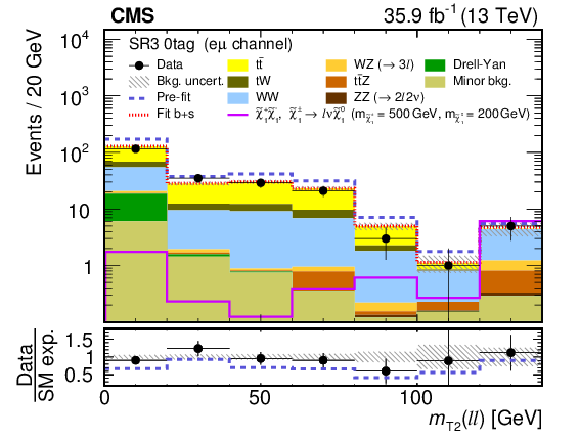
png pdf |
Figure 4-e:
Distribution of ${{m_\mathrm {T2}} (\ell \ell)}$ after the fit to data in the chargino SR with $ {{p_{\mathrm {T}}} ^\text {miss}} > $ 300 GeV for DF events without b-tagged jets regardless of their jet multiplicity. The solid magenta histogram shows the expected ${{m_\mathrm {T2}} (\ell \ell)}$ distribution for chargino pair production with $ {m_{\tilde{\chi}^\pm _{1}}} = $ 500 GeV and $ {m_{\tilde{\chi}^{0}_{1}}} = $ 200 GeV. Expected total SM contributions before the fit (dark blue dashed line) and after a background+signal fit (dark red dotted line) are also shown. The last bin includes the overflow entries. In the bottom panel, the ratio of data and SM expectations is shown for the expected total SM contribution after the fit using the background-only hypothesis (black dots) and before any fit (dark blue dashed line). The hatched band represents the total uncertainty after the fit. |
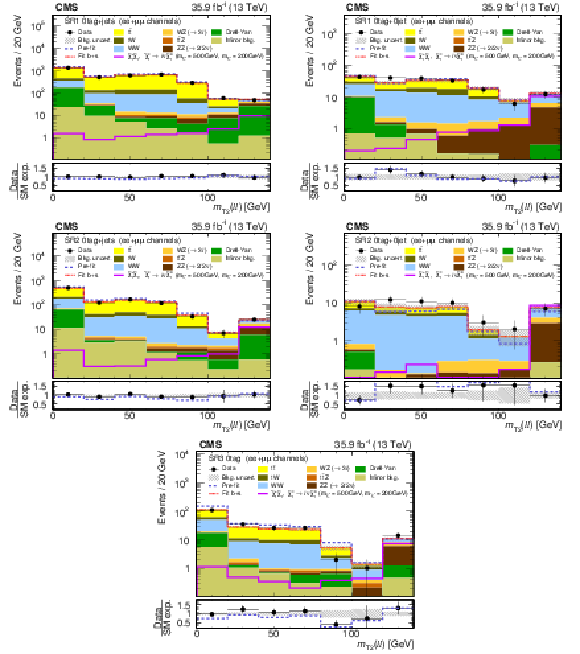
png pdf |
Figure 5:
The same distributions of ${{m_\mathrm {T2}} (\ell \ell)}$ as Fig. 4, but for SF events. |

png pdf |
Figure 5-a:
The same distribution of ${{m_\mathrm {T2}} (\ell \ell)}$ as Fig. 4-a, but for SF events. |

png pdf |
Figure 5-b:
The same distribution of ${{m_\mathrm {T2}} (\ell \ell)}$ as Fig. 4-b, but for SF events. |
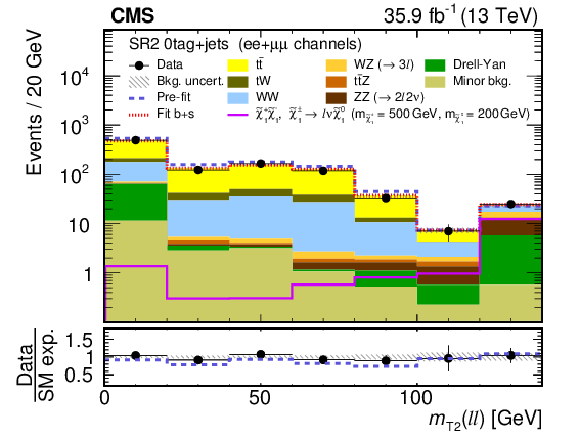
png pdf |
Figure 5-c:
The same distribution of ${{m_\mathrm {T2}} (\ell \ell)}$ as Fig. 4-c, but for SF events. |
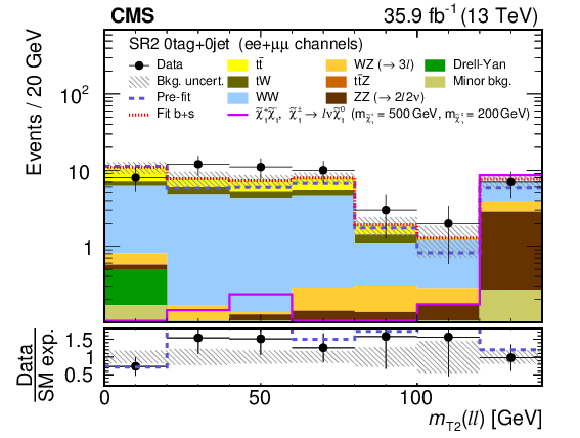
png pdf |
Figure 5-d:
The same distribution of ${{m_\mathrm {T2}} (\ell \ell)}$ as Fig. 4-d, but for SF events. |

png pdf |
Figure 5-e:
The same distribution of ${{m_\mathrm {T2}} (\ell \ell)}$ as Fig. 4-e, but for SF events. |

png pdf |
Figure 6:
Distributions of ${{m_\mathrm {T2}} (\ell \ell)}$ after the fit to data in the top squark SRs with 140 $ < {{p_{\mathrm {T}}} ^\text {miss}} < $ 200 GeV (upper plots), 200 $ < {{p_{\mathrm {T}}} ^\text {miss}} < $ 300 GeV (middle), or $ {{p_{\mathrm {T}}} ^\text {miss}} > $ 300 GeV (lower), for DF events with b-tagged jets (left plots) and without b-tagged jets (right plots). The solid magenta histogram shows the expected ${{m_\mathrm {T2}} (\ell \ell)}$ distribution for top squark pair production with $ {m_{\tilde{\mathrm {t}}_1}} = $ 350 GeV and $ {m_{\tilde{\chi}^{0}_{1}}} = $ 225 GeV. Expected total SM contributions before the fit (dark blue dashed line) and after a background+signal fit (dark red dotted line) are also shown. The last bin includes the overflow entries. In the bottom panel, the ratio of data and SM expectations is shown for the expected total SM contribution after the fit using the background-only hypothesis (black dots) and before any fit (dark blue dashed line). The hatched band represents the total uncertainty after the fit. |

png pdf |
Figure 6-a:
Distribution of ${{m_\mathrm {T2}} (\ell \ell)}$ after the fit to data in the top squark SR with 140 $ < {{p_{\mathrm {T}}} ^\text {miss}} < $ 200 GeV, for DF events with b-tagged jets. The solid magenta histogram shows the expected ${{m_\mathrm {T2}} (\ell \ell)}$ distribution for top squark pair production with $ {m_{\tilde{\mathrm {t}}_1}} = $ 350 GeV and $ {m_{\tilde{\chi}^{0}_{1}}} = $ 225 GeV. Expected total SM contributions before the fit (dark blue dashed line) and after a background+signal fit (dark red dotted line) are also shown. The last bin includes the overflow entries. In the bottom panel, the ratio of data and SM expectations is shown for the expected total SM contribution after the fit using the background-only hypothesis (black dots) and before any fit (dark blue dashed line). The hatched band represents the total uncertainty after the fit. |

png pdf |
Figure 6-b:
Distribution of ${{m_\mathrm {T2}} (\ell \ell)}$ after the fit to data in the top squark SR with 140 $ < {{p_{\mathrm {T}}} ^\text {miss}} < $ 200 GeV, for DF events without b-tagged jets. The solid magenta histogram shows the expected ${{m_\mathrm {T2}} (\ell \ell)}$ distribution for top squark pair production with $ {m_{\tilde{\mathrm {t}}_1}} = $ 350 GeV and $ {m_{\tilde{\chi}^{0}_{1}}} = $ 225 GeV. Expected total SM contributions before the fit (dark blue dashed line) and after a background+signal fit (dark red dotted line) are also shown. The last bin includes the overflow entries. In the bottom panel, the ratio of data and SM expectations is shown for the expected total SM contribution after the fit using the background-only hypothesis (black dots) and before any fit (dark blue dashed line). The hatched band represents the total uncertainty after the fit. |

png pdf |
Figure 6-c:
Distribution of ${{m_\mathrm {T2}} (\ell \ell)}$ after the fit to data in the top squark SR with 200 $ < {{p_{\mathrm {T}}} ^\text {miss}} < $ 300 GeV, for DF events with b-tagged jets. The solid magenta histogram shows the expected ${{m_\mathrm {T2}} (\ell \ell)}$ distribution for top squark pair production with $ {m_{\tilde{\mathrm {t}}_1}} = $ 350 GeV and $ {m_{\tilde{\chi}^{0}_{1}}} = $ 225 GeV. Expected total SM contributions before the fit (dark blue dashed line) and after a background+signal fit (dark red dotted line) are also shown. The last bin includes the overflow entries. In the bottom panel, the ratio of data and SM expectations is shown for the expected total SM contribution after the fit using the background-only hypothesis (black dots) and before any fit (dark blue dashed line). The hatched band represents the total uncertainty after the fit. |

png pdf |
Figure 6-d:
Distribution of ${{m_\mathrm {T2}} (\ell \ell)}$ after the fit to data in the top squark SR with 200 $ < {{p_{\mathrm {T}}} ^\text {miss}} < $ 300 GeV, for DF events without b-tagged jets. The solid magenta histogram shows the expected ${{m_\mathrm {T2}} (\ell \ell)}$ distribution for top squark pair production with $ {m_{\tilde{\mathrm {t}}_1}} = $ 350 GeV and $ {m_{\tilde{\chi}^{0}_{1}}} = $ 225 GeV. Expected total SM contributions before the fit (dark blue dashed line) and after a background+signal fit (dark red dotted line) are also shown. The last bin includes the overflow entries. In the bottom panel, the ratio of data and SM expectations is shown for the expected total SM contribution after the fit using the background-only hypothesis (black dots) and before any fit (dark blue dashed line). The hatched band represents the total uncertainty after the fit. |
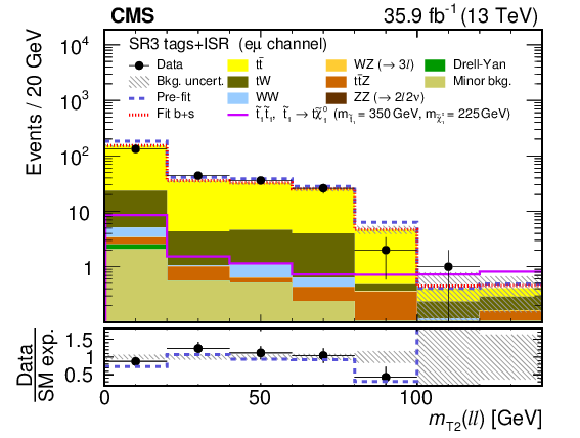
png pdf |
Figure 6-e:
Distribution of ${{m_\mathrm {T2}} (\ell \ell)}$ after the fit to data in the top squark SR with $ {{p_{\mathrm {T}}} ^\text {miss}} > $ 300 GeV, for DF events with b-tagged jets. The solid magenta histogram shows the expected ${{m_\mathrm {T2}} (\ell \ell)}$ distribution for top squark pair production with $ {m_{\tilde{\mathrm {t}}_1}} = $ 350 GeV and $ {m_{\tilde{\chi}^{0}_{1}}} = $ 225 GeV. Expected total SM contributions before the fit (dark blue dashed line) and after a background+signal fit (dark red dotted line) are also shown. The last bin includes the overflow entries. In the bottom panel, the ratio of data and SM expectations is shown for the expected total SM contribution after the fit using the background-only hypothesis (black dots) and before any fit (dark blue dashed line). The hatched band represents the total uncertainty after the fit. |
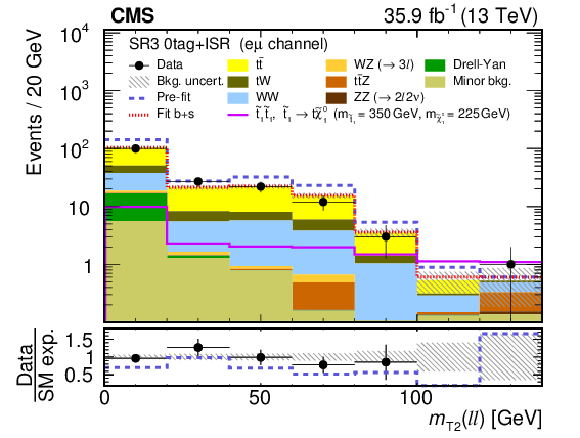
png pdf |
Figure 6-f:
Distribution of ${{m_\mathrm {T2}} (\ell \ell)}$ after the fit to data in the top squark SR with $ {{p_{\mathrm {T}}} ^\text {miss}} > $ 300 GeV, for DF events without b-tagged jets. The solid magenta histogram shows the expected ${{m_\mathrm {T2}} (\ell \ell)}$ distribution for top squark pair production with $ {m_{\tilde{\mathrm {t}}_1}} = $ 350 GeV and $ {m_{\tilde{\chi}^{0}_{1}}} = $ 225 GeV. Expected total SM contributions before the fit (dark blue dashed line) and after a background+signal fit (dark red dotted line) are also shown. The last bin includes the overflow entries. In the bottom panel, the ratio of data and SM expectations is shown for the expected total SM contribution after the fit using the background-only hypothesis (black dots) and before any fit (dark blue dashed line). The hatched band represents the total uncertainty after the fit. |

png pdf |
Figure 7:
The same distributions of ${{m_\mathrm {T2}} (\ell \ell)}$ as Fig. 6, but for SF events. |
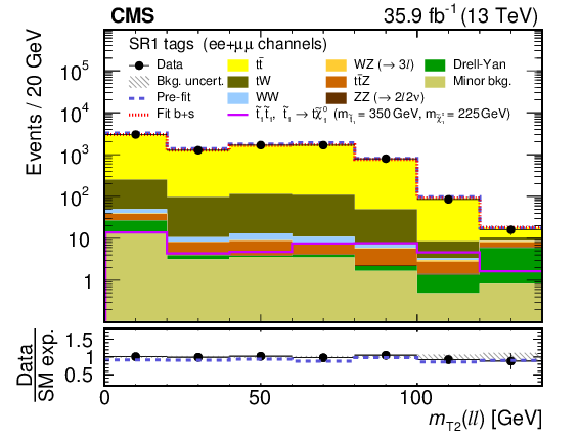
png pdf |
Figure 7-a:
The same distribution of ${{m_\mathrm {T2}} (\ell \ell)}$ as Fig. 6-a, but for SF events. |

png pdf |
Figure 7-b:
The same distribution of ${{m_\mathrm {T2}} (\ell \ell)}$ as Fig. 6-b, but for SF events. |
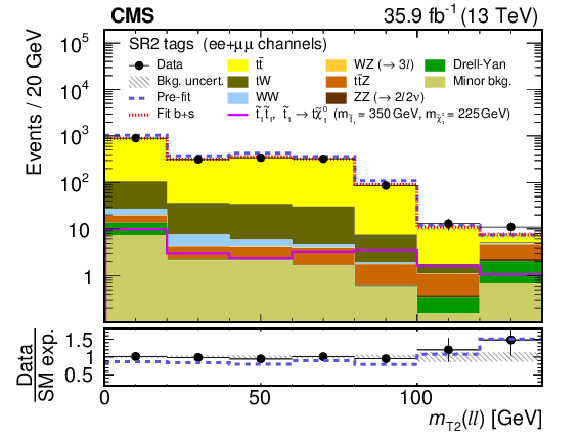
png pdf |
Figure 7-c:
The same distribution of ${{m_\mathrm {T2}} (\ell \ell)}$ as Fig. 6-c, but for SF events. |
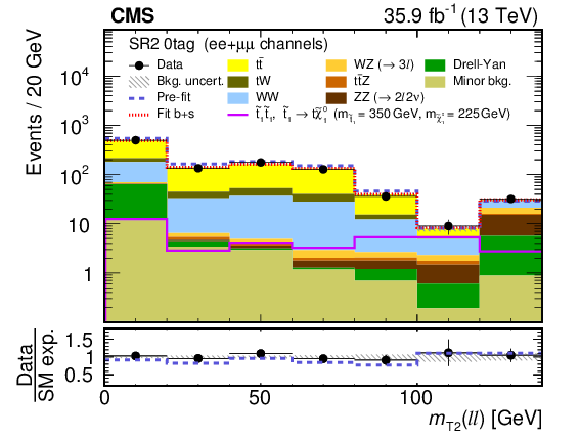
png pdf |
Figure 7-d:
The same distribution of ${{m_\mathrm {T2}} (\ell \ell)}$ as Fig. 6-d, but for SF events. |

png pdf |
Figure 7-e:
The same distribution of ${{m_\mathrm {T2}} (\ell \ell)}$ as Fig. 6-e, but for SF events. |

png pdf |
Figure 7-f:
The same distribution of ${{m_\mathrm {T2}} (\ell \ell)}$ as Fig. 6-f, but for SF events. |
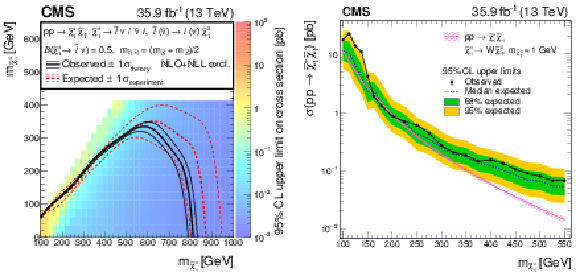
png pdf |
Figure 8:
Left: upper limits at 95% CL on the chargino pair production cross section as a function of the chargino and neutralino masses, when the chargino undergoes a cascade decay ${\tilde{\chi}^\pm _{1}} \to {\tilde{\ell}}\nu (\ell {\tilde{\nu}} ) \to \ell \nu \tilde{\chi}^{0}_{1}$. Exclusion regions in the plane (${m_{\tilde{\chi}^\pm _{1}}}$, ${m_{\tilde{\chi}^{0}_{1}}}$) are determined by comparing the upper limits with the NLO+NLL production cross sections. The thick dashed red line shows the expected exclusion region. The thin dashed red lines show the variation of the exclusion regions due to the experimental uncertainties. The thick black line shows the observed exclusion region, while the thin black lines show the variation of the exclusion regions due to the theoretical uncertainties in the production cross section. Right: observed and expected upper limits at 95% CL as a function of the chargino mass for a neutralino mass of 1 GeV, assuming chargino decays into a neutralino and a W boson ($ \tilde{\chi}^\pm _{1} \to {\mathrm {W}} \tilde{\chi}^{0}_{1} $). |

png pdf root |
Figure 8-a:
Upper limits at 95% CL on the chargino pair production cross section as a function of the chargino and neutralino masses, when the chargino undergoes a cascade decay ${\tilde{\chi}^\pm _{1}} \to {\tilde{\ell}}\nu (\ell {\tilde{\nu}} ) \to \ell \nu \tilde{\chi}^{0}_{1}$. Exclusion regions in the plane (${m_{\tilde{\chi}^\pm _{1}}}$, ${m_{\tilde{\chi}^{0}_{1}}}$) are determined by comparing the upper limits with the NLO+NLL production cross sections. The thick dashed red line shows the expected exclusion region. The thin dashed red lines show the variation of the exclusion regions due to the experimental uncertainties. The thick black line shows the observed exclusion region, while the thin black lines show the variation of the exclusion regions due to the theoretical uncertainties in the production cross section. |

png pdf root |
Figure 8-b:
Observed and expected upper limits at 95% CL as a function of the chargino mass for a neutralino mass of 1 GeV, assuming chargino decays into a neutralino and a W boson ($ \tilde{\chi}^\pm _{1} \to {\mathrm {W}} \tilde{\chi}^{0}_{1} $). |
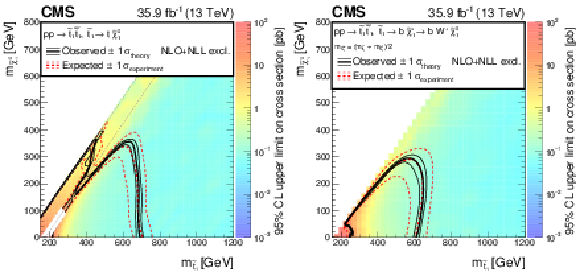
png pdf |
Figure 9:
Upper limits at 95% CL on the top squark production cross section as a function of the top squark and neutralino masses. The plot on the left shows the results when top squark decays into a top quark and a neutralino are assumed. The two diagonal gray dashed lines enclose the compressed region where $ {m_{{\mathrm {W}}}} < {m_{\tilde{\mathrm {t}}_1}} - {m_{\tilde{\chi}^{0}_{1}}} < {m_{{\mathrm {t}}}} $. The plot on the right gives the limits for top squarks decaying into a bottom quark and a chargino, with the latter successively decaying into a W boson and a neutralino. The mass of the chargino is assumed to be equal to the average of the top squark and neutralino masses. Exclusion regions in the plane (${m_{\tilde{\mathrm {t}}_1}}$, ${m_{\tilde{\chi}^{0}_{1}}}$) are determined by comparing the upper limits with the NLO+NLL production cross sections. The thick dashed red line shows the expected exclusion region. The thin dashed red lines show the variation of the exclusion regions due to the experimental uncertainties. The thick black line shows the observed exclusion region, while the thin black lines show the variation of the exclusion regions due to the theoretical uncertainties in the production cross section. |
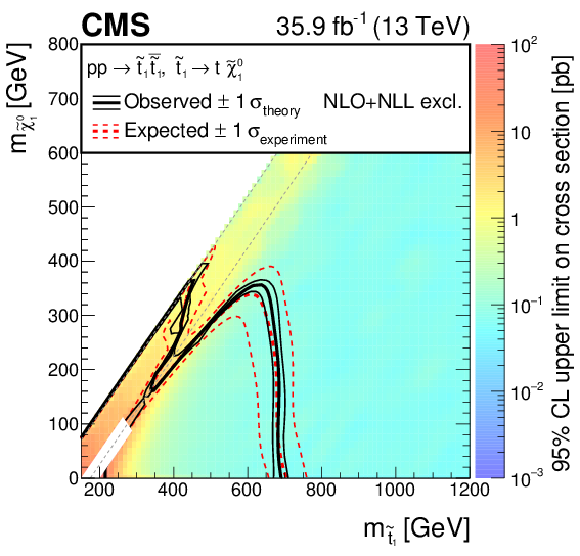
png pdf root |
Figure 9-a:
Upper limits at 95% CL on the top squark production cross section as a function of the top squark and neutralino masses. The plot shows the results when top squark decays into a top quark and a neutralino are assumed. The two diagonal gray dashed lines enclose the compressed region where $ {m_{{\mathrm {W}}}} < {m_{\tilde{\mathrm {t}}_1}} - {m_{\tilde{\chi}^{0}_{1}}} < {m_{{\mathrm {t}}}} $. Exclusion regions in the plane (${m_{\tilde{\mathrm {t}}_1}}$, ${m_{\tilde{\chi}^{0}_{1}}}$) are determined by comparing the upper limits with the NLO+NLL production cross sections. The thick dashed red line shows the expected exclusion region. The thin dashed red lines show the variation of the exclusion regions due to the experimental uncertainties. The thick black line shows the observed exclusion region, while the thin black lines show the variation of the exclusion regions due to the theoretical uncertainties in the production cross section. |
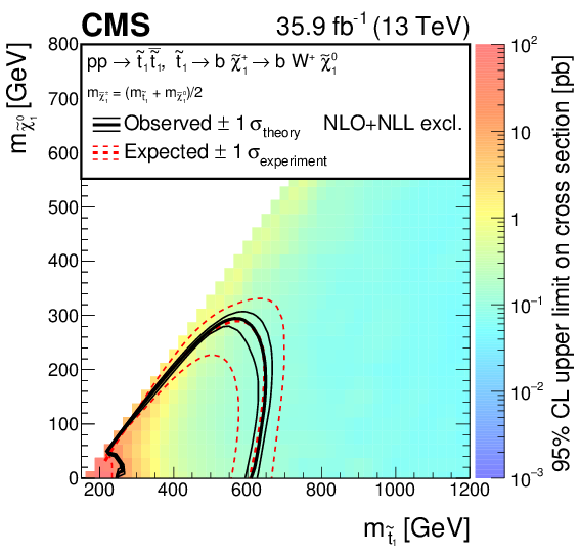
png pdf root |
Figure 9-b:
Upper limits at 95% CL on the top squark production cross section as a function of the top squark and neutralino masses. The plot gives the limits for top squarks decaying into a bottom quark and a chargino, with the latter successively decaying into a W boson and a neutralino. The mass of the chargino is assumed to be equal to the average of the top squark and neutralino masses. Exclusion regions in the plane (${m_{\tilde{\mathrm {t}}_1}}$, ${m_{\tilde{\chi}^{0}_{1}}}$) are determined by comparing the upper limits with the NLO+NLL production cross sections. The thick dashed red line shows the expected exclusion region. The thin dashed red lines show the variation of the exclusion regions due to the experimental uncertainties. The thick black line shows the observed exclusion region, while the thin black lines show the variation of the exclusion regions due to the theoretical uncertainties in the production cross section. |
| Tables | |
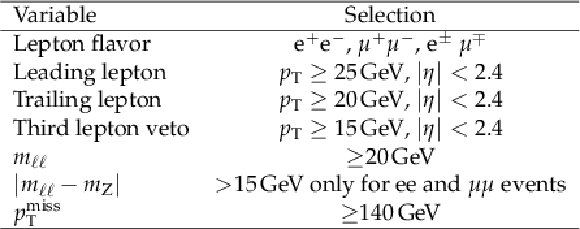
png pdf |
Table 1:
Definition of the baseline selection used in the searches for chargino and top squark pair production. |

png pdf |
Table 2:
Definition of the SRs for the chargino search as a function of the ${{p_{\mathrm {T}}} ^\text {miss}} $ value, the b-jet multiplicity and jet multiplicity. Also shown are the CRs with b-tagged jets used for the normalization of the ${{\mathrm {t}\overline {\mathrm {t}}}}$ and ${{\mathrm {t}} {\mathrm {W}}}$ backgrounds. Each of the regions is further divided in seven ${{m_\mathrm {T2}} (\ell \ell)}$ bins as described in the last row. |

png pdf |
Table 3:
Definition of the SRs for the top squark production search as a function of the ${{p_{\mathrm {T}}} ^\text {miss}} $ value, the b-jet multiplicity and the ISR jet requirement. Each of the regions is further divided in seven ${{m_\mathrm {T2}} (\ell \ell)}$ bins as described in the last row. |

png pdf |
Table 4:
Summary of the normalization scale factors for ${{{\mathrm {t}\overline {\mathrm {t}}}} {\mathrm {Z}}}$, ${{\mathrm {W}} {\mathrm {Z}}}$, and ${{\mathrm {Z}} {\mathrm {Z}}}$ backgrounds in the SRs used for the chargino (a) and top squark (b) searches. Uncertainties include the statistical uncertainties of data and simulated event samples, and the systematic uncertainties in the purity of the CRs. |

png pdf |
Table 5:
Sizes of systematic uncertainties in the predicted yields for SM processes. The first column shows the range of the uncertainties in the global background normalization across the different SRs. The second column quantifies the effect on the ${{m_\mathrm {T2}} (\ell \ell)}$ shape. This is computed by taking the maximum variation across the ${{m_\mathrm {T2}} (\ell \ell)}$ bins (after renormalizing for the global change of all the distribution) in each SR. The range of this variation across the SRs is given. |
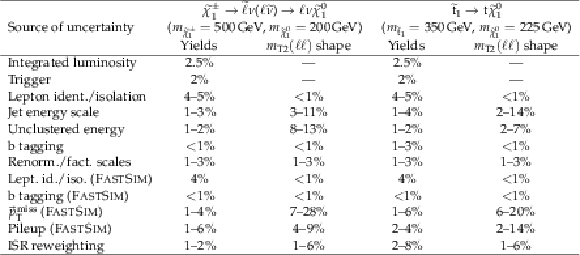
png pdf |
Table 6:
Same as in Table 5 for two representative signal points, one for chargino pair production and one for top squark pair production. |

png pdf |
Table 7:
Observed and expected yields of DF (the upper half of Table) and SF (the lower half) events in the SRs for the chargino search. The quoted uncertainties in the background predictions include statistical and systematic contributions. |

png pdf |
Table 8:
Observed and expected yields of DF (the upper half of Table) and SF (the lower half) events in the SRs for the top squark search. The quoted uncertainties in the background predictions include statistical and systematic contributions. |
| Summary |
|
A search has been presented for pair production of supersymmetric particles in events with two oppositely charged isolated leptons and missing transverse momentum. The data used consist of a sample of proton-proton collisions collected with the CMS detector during the 2016 LHC run at a center-of-mass energy of 13 TeV, corresponding to an integrated luminosity of 35.9 fb$^{-1}$. No evidence for a deviation with respect to standard model predictions was observed in data. The results have been interpreted as upper limits on the cross sections of supersymmetric particle production for several simplified model spectra. Chargino pair production has been investigated in two possible decay modes. If the chargino is assumed to undergo a cascade decay through sleptons, an exclusion region in the ($m_{\tilde{\chi}^{\pm}_1}$, $m_{\tilde{\chi}^0_1}$) plane can be derived, extending to chargino masses of 800 GeV and neutralino masses of 320 GeV. These are the most stringent limits on this model to date. For chargino decays into a neutralino and a W boson, limits on the production cross section have been derived assuming a neutralino mass of 1 GeV, and chargino masses in the range 170-200 GeV have been excluded. Top squark pair production was also tested, with a focus on compressed decay modes. A model with the top squark decaying into a top quark and a neutralino was considered. In the region where $m_{\mathrm{W}} < m_{\tilde{\mathrm{t}}_{1}}-m_{\tilde{\chi}^0_1} < m_{\mathrm{t}}$, limits extend up to 420 and 360 GeV for the top squark and neutralino masses, respectively. An alternative model has also been considered, where the top squark decays into a chargino and a bottom quark, with the chargino subsequently decaying into a W boson and the lightest neutralino. The mass of the chargino is assumed to be average between the top squark and neutralino masses, which gives a lower bound to the mass difference (${\Delta m} $) between the top squark and the neutralino of ${\Delta m} \approx 2\,m_{\mathrm{W}}$. This search reduces by about 50 GeV the minimum ${\Delta m}$ excluded in the previous result with two leptons in the final state [30] from the CMS Collaboration, excluding top squark masses in the range 225-325 GeV for ${\Delta m} \approx 2\,m_{\mathrm{W}}$. In summary, by exploiting the full data set collected by the CMS experiment in 2016, this search extends the existing exclusion limits on the pair production of charginos decaying via sleptons [29], improving by about 70 GeV the limit on the chargino mass for a massless neutralino. Exclusion limits on the top squark pair production extend the results obtained by the CMS Collaboration in final states with two oppositely charged leptons [30] to the compressed region, where they are competitive with the results obtained by the ATLAS Collaboration in the same decay channel [35]. |
| Additional Figures | |
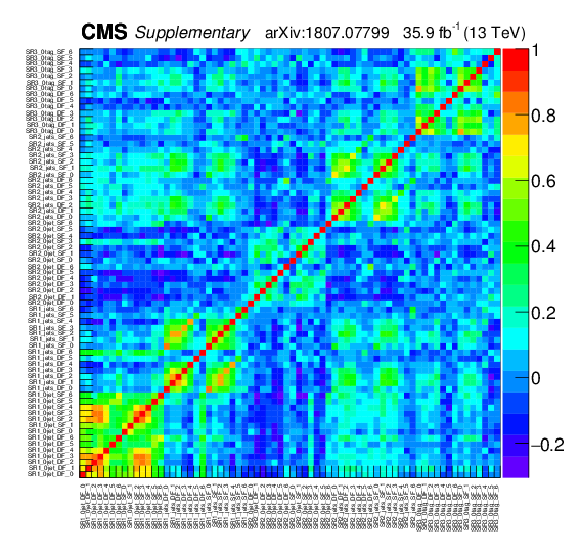
png pdf root |
Additional Figure 1:
Correlation matrix for the background between the signal regions used in the chargino pair production search. |
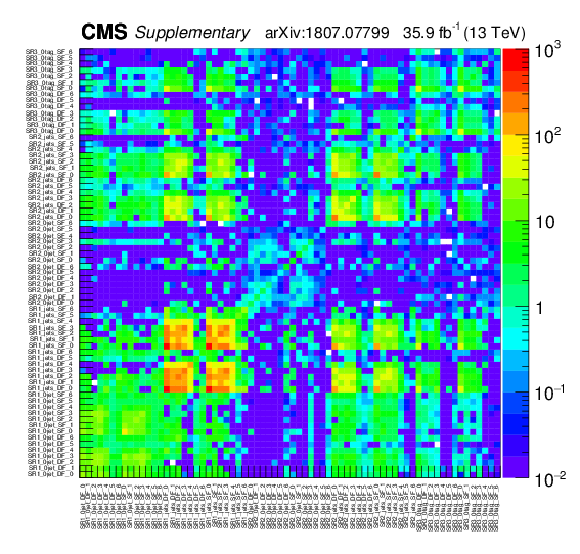
png pdf root |
Additional Figure 2:
Covariance matrix for the background between the signal regions used in the chargino pair production search. |
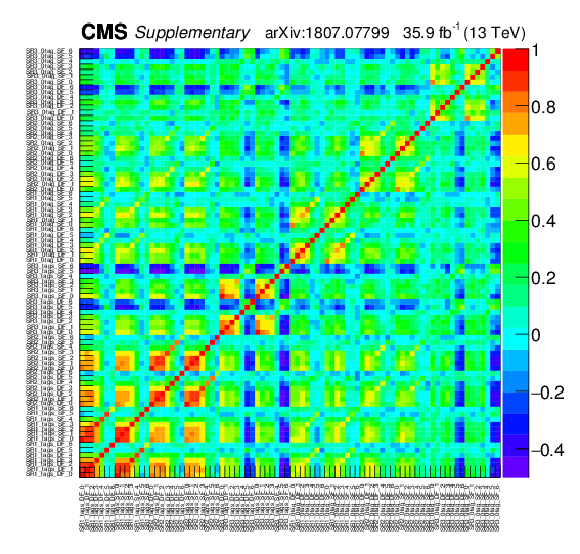
png pdf root |
Additional Figure 3:
Correlation matrix for the background between the signal regions used in the top squark pair production search. |

png pdf root |
Additional Figure 4:
Covariance matrix for the background between the signal regions used in the top squark pair production search. |
| Additional Tables | |

png pdf |
Additional Table 1:
Expected signal yields at different stages of the baseline event selection for two representative signal points, one for chargino pair production and one for top squark pair production. The yields are normalized to an integrated luminosity of 35.9 fb$^{-1}$. |

png pdf |
Additional Table 2:
Expected yields of DF (the upper half of Table) and SF (the lower half) events in the signal regions used in the chargino search, for a reference ${{\tilde{\chi}^\pm _{1}} \to {\tilde{\ell}}\nu \text (\ell {\tilde{\nu}} \text )\to \ell \nu {\tilde{\chi}^{0}_{1}}}$ signal with $ {m_{{\tilde{\chi}^\pm _{1}}}} = $ 500 GeV and $ {m_{{\tilde{\chi}^{0}_{1}}}} = $ 200 GeV. The yields are normalized to an integrated luminosity of 35.9 fb$^{-1}$. Quoted uncertainties are statistical only. |
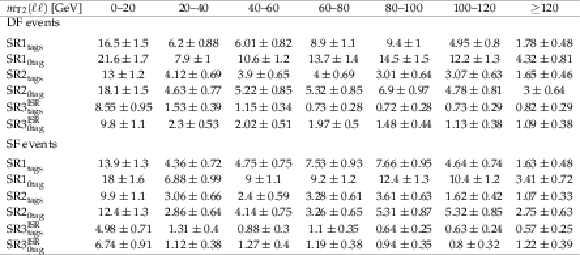
png pdf |
Additional Table 3:
Expected yields of DF (the upper half of Table) and SF (the lower half) events in the signal regions used in the top squark search, for a reference $ {\tilde{\mathrm {t}}_1} \to {\mathrm {t}} {\tilde{\chi}^{0}_{1}} $ signal with $ {m_{{\tilde{\mathrm {t}}_1}}} = $ 350 GeV and $ {m_{{\tilde{\chi}^{0}_{1}}}} = $ 225 GeV. The yields are normalized to an integrated luminosity of 35.9 fb$^{-1}$. Quoted uncertainties are statistical only. |
| References | ||||
| 1 | E. Gildener and S. Weinberg | Symmetry breaking and scalar bosons | PRD 13 (1976) 3333 | |
| 2 | G. 't Hooft | Naturalness, chiral symmetry, and spontaneous chiral symmetry breaking | NATO Sci. Ser. B 59 (1980) 135 | |
| 3 | G. Bertone, D. Hooper, and J. Silk | Particle dark matter: evidence, candidates and constraints | PR 405 (2005) 279 | hep-ph/0404175 |
| 4 | J. L. Feng | Dark matter candidates from particle physics and methods of detection | Ann. Rev. Astron. Astrophys. 48 (2010) 495 | 1003.0904 |
| 5 | T. A. Porter, R. P. Johnson, and P. W. Graham | Dark matter searches with astroparticle data | Ann. Rev. Astron. Astrophys. 49 (2011) 155 | 1104.2836 |
| 6 | P. Ramond | Dual theory for free fermions | PRD 3 (1971) 2415 | |
| 7 | Y. A. Golfand and E. P. Likhtman | Extension of the algebra of Poincar$ \'e $ group generators and violation of P invariance | JEPTL 13 (1971)323 | |
| 8 | A. Neveu and J. H. Schwarz | Factorizable dual model of pions | NPB 31 (1971) 86 | |
| 9 | D. V. Volkov and V. P. Akulov | Possible universal neutrino interaction | JEPTL 16 (1972)438 | |
| 10 | J. Wess and B. Zumino | A Lagrangian model invariant under supergauge transformations | PLB 49 (1974) 52 | |
| 11 | J. Wess and B. Zumino | Supergauge transformations in four dimensions | NPB 70 (1974) 39 | |
| 12 | P. Fayet | Supergauge invariant extension of the Higgs mechanism and a model for the electron and its neutrino | NPB 90 (1975) 104 | |
| 13 | H. P. Nilles | Supersymmetry, supergravity and particle physics | Phys. Rep. 110 (1984) 1 | |
| 14 | S. P. Martin | A Supersymmetry primer | Advanced Series on Directions in High Energy Physics 18 (2016) 1 | hep-ph/9709356 |
| 15 | E. Witten | Dynamical breaking of supersymmetry | NPB 188 (1981) 513 | |
| 16 | S. Dimopoulos and H. Georgi | Softly broken supersymmetry and SU(5) | NPB 193 (1981) 150 | |
| 17 | Kaul, R. K. and Majumdar, P. | Cancellation of quadratically divergent mass corrections in globally supersymmetric spontaneously broken gauge theories | NPB 199 (1982) 36 | |
| 18 | G. R. Farrar and P. Fayet | Phenomenology of the production, decay, and detection of new hadronic states associated with supersymmetry | PLB 76 (1978) 575 | |
| 19 | CMS Collaboration | The CMS experiment at the CERN LHC | JINST 3 (2008) S08004 | CMS-00-001 |
| 20 | J. Alwall, P. Schuster, and N. Toro | Simplified models for a first characterization of new physics at the LHC | PRD 79 (2009) 075020 | 0810.3921 |
| 21 | J. Alwall, M.-P. Le, M. Lisanti, and J. G. Wacker | Model-independent jets plus missing energy searches | PRD 79 (2009) 015005 | 0809.3264 |
| 22 | D. Alves et al. | Simplified models for LHC new physics searches | JPG 39 (2012) 105005 | 1105.2838 |
| 23 | CMS Collaboration | Searches for electroweak production of charginos, neutralinos, and sleptons decaying to leptons and W, Z, and Higgs bosons in pp collisions at 8 TeV | EPJC 74 (2014) 3036 | CMS-SUS-13-006 1405.7570 |
| 24 | ATLAS Collaboration | Search for direct production of charginos, neutralinos and sleptons in final states with two leptons and missing transverse momentum in pp collisions at $ \sqrt{s} = $ 8 TeV with the ATLAS detector | JHEP 05 (2014) 071 | 1403.5294 |
| 25 | ATLAS Collaboration | Search for the direct production of charginos, neutralinos and staus in final states with at least two hadronically decaying taus and missing transverse momentum in pp collisions at $ \sqrt{s} = $ 8 TeV with the ATLAS detector | JHEP 10 (2014) 096 | 1407.0350 |
| 26 | ATLAS Collaboration | Search for the electroweak production of supersymmetric particles in $ \sqrt{s} = $ 8 TeV pp collisions with the ATLAS detector | PRD 93 (2016) 052002 | 1509.07152 |
| 27 | ATLAS Collaboration | Search for the direct production of charginos and neutralinos in final states with tau leptons in $ \sqrt{s} = $ 13 TeV pp collisions with the ATLAS detector | EPJC 78 (2018) 154 | 1708.07875 |
| 28 | ATLAS Collaboration | Search for electroweak production of supersymmetric states in scenarios with compressed mass spectra at $ \sqrt{s}= $ 13 TeV with the ATLAS detector | PRD 97 (2018) 052010 | 1712.08119 |
| 29 | ATLAS Collaboration | Search for electroweak production of supersymmetric particles in final states with two or three leptons at $ \sqrt{s}= $ 13 TeV with the ATLAS detector | Submitted to EPJC | 1803.02762 |
| 30 | CMS Collaboration | Search for top squarks and dark matter particles in opposite-charge dilepton final states at $ \sqrt{s} = $ 13 TeV | PRD 97 (2018) 032009 | CMS-SUS-17-001 1711.00752 |
| 31 | CMS Collaboration | Search for top squark pair production in pp collisions at $ \sqrt{s} = $ 13 TeV using single lepton events | JHEP 10 (2017) 019 | CMS-SUS-16-051 1706.04402 |
| 32 | CMS Collaboration | Search for direct production of supersymmetric partners of the top quark in the all-jets final state in proton-proton collisions at $ \sqrt{s} = $ 13 TeV | JHEP 10 (2017) 005 | CMS-SUS-16-049 1707.03316 |
| 33 | ATLAS Collaboration | Search for a scalar partner of the top quark in the jets plus missing transverse momentum final state at $ \sqrt{s}= $ 13 TeV with the ATLAS detector | JHEP 12 (2017) 085 | 1709.04183 |
| 34 | ATLAS Collaboration | Search for top-squark pair production in final states with one lepton, jets, and missing transverse momentum using $ 36 fb$^{-1} of $ \sqrt{s}= $ 13 TeV pp collision data with the ATLAS detector | Submitted to JHEP | 1711.11520 |
| 35 | ATLAS Collaboration | Search for direct top squark pair production in final states with two leptons in $ \sqrt{s}= $ 13 TeV pp collisions with the ATLAS detector | EPJC 77 (2017) 898 | 1708.03247 |
| 36 | CMS Collaboration | The CMS trigger system | JINST 12 (2017) P01020 | CMS-TRG-12-001 1609.02366 |
| 37 | P. Nason | A new method for combining NLO QCD with shower Monte Carlo algorithms | JHEP 11 (2004) 040 | hep-ph/0409146 |
| 38 | S. Frixione, P. Nason, and C. Oleari | Matching NLO QCD computations with parton shower simulations: the POWHEG method | JHEP 11 (2007) 070 | 0709.2092 |
| 39 | S. Alioli, P. Nason, C. Oleari, and E. Re | A general framework for implementing NLO calculations in shower Monte Carlo programs: the POWHEG BOX | JHEP 06 (2010) 043 | 1002.2581 |
| 40 | M. Czakon and A. Mitov | Top++: A program for the calculation of the top-pair cross-section at hadron colliders | CPC 185 (2014) 2930 | 1112.5675 |
| 41 | E. Re | Single-top Wt-channel production matched with parton showers using the POWHEG method | EPJC 71 (2011) 1547 | 1009.2450 |
| 42 | Kidonakis, N. | NNLL threshold resummation for top-pair and single-top production | Phys. Part. Nucl. 45 (2014) 714 | 1210.7813 |
| 43 | Melia, T. and Nason, P. and Rontsch, R. and Zanderighi, G. | W$ ^+ $W$ ^- $, WZ and ZZ production in the POWHEG BOX | JHEP 11 (2011) 078 | 1107.5051 |
| 44 | P. Nason and G. Zanderighi | W$ ^+ $W$ ^- $, WZ and ZZ production in the POWHEG-BOX-V2 | EPJC 74 (2014) 2702 | 1311.1365 |
| 45 | T. Gehrmann et al. | W$ ^{+} $W$ ^{-} $ production at hadron colliders in NNLO QCD | PRL 113 (2014) 212001 | 1408.5243 |
| 46 | CMS Collaboration | Measurements of properties of the Higgs boson decaying into the four-lepton final state in pp collisions at $ \sqrt{s}= $ 13 TeV | JHEP 11 (2017) 047 | CMS-HIG-16-041 1706.09936 |
| 47 | J. M. Campbell and R. K. Ellis | MCFM for the Tevatron and the LHC | NPPS 205 (2010) 10 | 1007.3492 |
| 48 | F. Caola, K. Melnikov, R. Rtsch, and L. Tancredi | QCD corrections to W$ ^+ $W$ ^{-} $ production through gluon fusion | PLB 754 (2016) 275 | 1511.08617 |
| 49 | J. Alwall et al. | The automated computation of tree-level and next-to-leading order differential cross sections, and their matching to parton shower simulations | JHEP 07 (2014) 079 | 1405.0301 |
| 50 | R. Gavin, Y. Li, F. Petriello, and S. Quackenbush | FEWZ 2.0: A code for hadronic Z production at next-to-next-to-leading order | CPC 182 (2011) 2388 | 1011.3540 |
| 51 | M. V. Garzelli, A. Kardos, C. G. Papadopoulos, and Z. Trocsanyi | $ \mathrm{t\bar{t}} $W$ ^{\pm} $ and $ \mathrm{t\bar{t}} $Z hadroproduction at NLO accuracy in QCD with parton shower and hadronization effects | JHEP 11 (2012) 056 | 1208.2665 |
| 52 | LHC Higgs Cross Section Working Group | Handbook of LHC Higgs cross sections: 3. Higgs Properties | CERN (2013) | 1307.1347 |
| 53 | W. Beenakker et al. | Production of charginos, neutralinos, and sleptons at hadron colliders | PRL 83 (1999) 3780 | hep-ph/9906298 |
| 54 | B. Fuks, M. Klasen, D. R. Lamprea, and M. Rothering | Gaugino production in proton-proton collisions at a center-of-mass energy of 8 TeV | JHEP 10 (2012) 081 | 1207.2159 |
| 55 | B. Fuks, M. Klasen, D. R. Lamprea, and M. Rothering | Precision predictions for electroweak superpartner production at hadron colliders with $ \sc $ resummino | EPJC 73 (2013) 2480 | 1304.0790 |
| 56 | W. Beenakker, R. Hopker, M. Spira, and P. M. Zerwas | Squark and gluino production at hadron colliders | NPB 492 (1997) 51 | hep-ph/9610490 |
| 57 | A. Kulesza and L. Motyka | Threshold resummation for squark-antisquark and gluino-pair production at the LHC | PRL 102 (2009) 111802 | 0807.2405 |
| 58 | A. Kulesza and L. Motyka | Soft gluon resummation for the production of gluino-gluino and squark-antisquark pairs at the LHC | PRD 80 (2009) 095004 | 0905.4749 |
| 59 | W. Beenakker et al. | Soft-gluon resummation for squark and gluino hadroproduction | JHEP 12 (2009) 041 | 0909.4418 |
| 60 | W. Beenakker et al. | Squark and gluino hadroproduction | Int. J. Mod. Phys. A 26 (2011) 2637 | 1105.1110 |
| 61 | C. Borschensky et al. | Squark and gluino production cross sections in pp collisions at $ \sqrt{s} = $ 13, 14, 33 and 100 TeV | EPJC 74 (2014) 3174 | 1407.5066 |
| 62 | NNPDF Collaboration | Parton distributions for the LHC Run II | JHEP 04 (2015) 040 | 1410.8849 |
| 63 | T. Sjostrand et al. | An Introduction to PYTHIA 8.2 | CPC 191 (2015) 159 | 1410.3012 |
| 64 | CMS Collaboration | Event generator tunes obtained from underlying event and multiparton scattering measurements | EPJC 76 (2016) 155 | CMS-GEN-14-001 1512.00815 |
| 65 | CMS Collaboration | Investigations of the impact of the parton shower tuning in Pythia 8 in the modelling of $ \mathrm{t\bar{t}} $ at $ \sqrt{s}= $ 8 TeV and 13 TeV | CDS | |
| 66 | A. Kalogeropoulos and J. Alwall | The SysCalc code: A tool to derive theoretical systematic uncertainties | 1801.08401 | |
| 67 | GEANT4 Collaboration | $ GEANT4--a $ simulation toolkit | NIMA 506 (2003) 250 | |
| 68 | S. Abdullin et al. | The Fast Simulation of the CMS detector at LHC | in J. Phys. Conf. Ser., volume 331, p. 032049 2011 | |
| 69 | CMS Collaboration | Search for top-squark pair production in the single-lepton final state in pp collisions at $ \sqrt{s}= $ 8 TeV | EPJC 73 (2013) 2677 | CMS-SUS-13-011 1308.1586 |
| 70 | CMS Collaboration | Particle-flow reconstruction and global event description with the CMS detector | JINST 12 (2017) P10003 | CMS-PRF-14-001 1706.04965 |
| 71 | M. Cacciari, G. P. Salam, and G. Soyez | The anti-$ {k_{\mathrm{T}}} $ jet clustering algorithm | JHEP 04 (2008) 063 | 0802.1189 |
| 72 | M. Cacciari, G. P. Salam, and G. Soyez | FastJet user manual | EPJC 72 (2012) 1896 | 1111.6097 |
| 73 | CMS Collaboration | Performance of CMS muon reconstruction in pp collision events at $ \sqrt{s} = $ 7 TeV | JINST 7 (2012) P10002 | CMS-MUO-10-004 1206.4071 |
| 74 | CMS Collaboration | Performance of electron reconstruction and selection with the CMS detector in proton-proton collisions at $ \sqrt{s} = $ 8 TeV | JINST 10 (2015) P06005 | CMS-EGM-13-001 1502.02701 |
| 75 | CMS Collaboration | Jet energy scale and resolution in the CMS experiment in pp collisions at 8 TeV | JINST 12 (2017) P02014 | CMS-JME-13-004 1607.03663 |
| 76 | CMS Collaboration | Identification of heavy-flavour jets with the CMS detector in pp collisions at 13 TeV | JINST 13 (2018) P05011 | CMS-BTV-16-002 1712.07158 |
| 77 | CMS Collaboration | Performance of the CMS missing transverse energy reconstruction in pp data at $ \sqrt{s}= $ 8 TeV | JINST 10 (2015) P02006 | CMS-JME-13-003 1411.0511 |
| 78 | C. G. Lester and D. J. Summers | Measuring masses of semiinvisibly decaying particles pair produced at hadron colliders | PLB 463 (1999) 99 | hep-ph/9906349 |
| 79 | CMS Collaboration | CMS luminosity measurements for the 2016 data-taking period | CMS-PAS-LUM-17-001 | CMS-PAS-LUM-17-001 |
| 80 | CMS Collaboration | Measurement of differential cross sections for top quark pair production using the lepton+jets final state in proton-proton collisions at 13 TeV | PRD 95 (2017) 092001 | CMS-TOP-16-008 1610.04191 |
| 81 | CMS Collaboration | Measurement of the differential cross section for top quark pair production in pp collisions at $ \sqrt{s}= $ 8 TeV | EPJC 75 (2015) 542 | CMS-TOP-12-028 1505.04480 |
| 82 | CMS Collaboration | Measurement of the $ \mathrm{t\bar{t}} $ production cross section in the all-jets final state in pp collisions at $ \sqrt{s}= $ 8 TeV | EPJC 76 (2016) 128 | CMS-TOP-14-018 1509.06076 |
| 83 | T. Junk | Confidence level computation for combining searches with small statistics | NIMA 434 (1999) 435 | hep-ex/9902006 |
| 84 | A. L. Read | Presentation of search results: The CL$ _{\text{s}} $ technique | JPG 28 (2002) 2693 | |
| 85 | G. Cowan, K. Cranmer, E. Gross, and O. Vitells | Asymptotic formulae for likelihood-based tests of new physics | EPJC 71 (2011) 1554 | 1007.1727 |

|
Compact Muon Solenoid LHC, CERN |

|

|

|

|

|

|